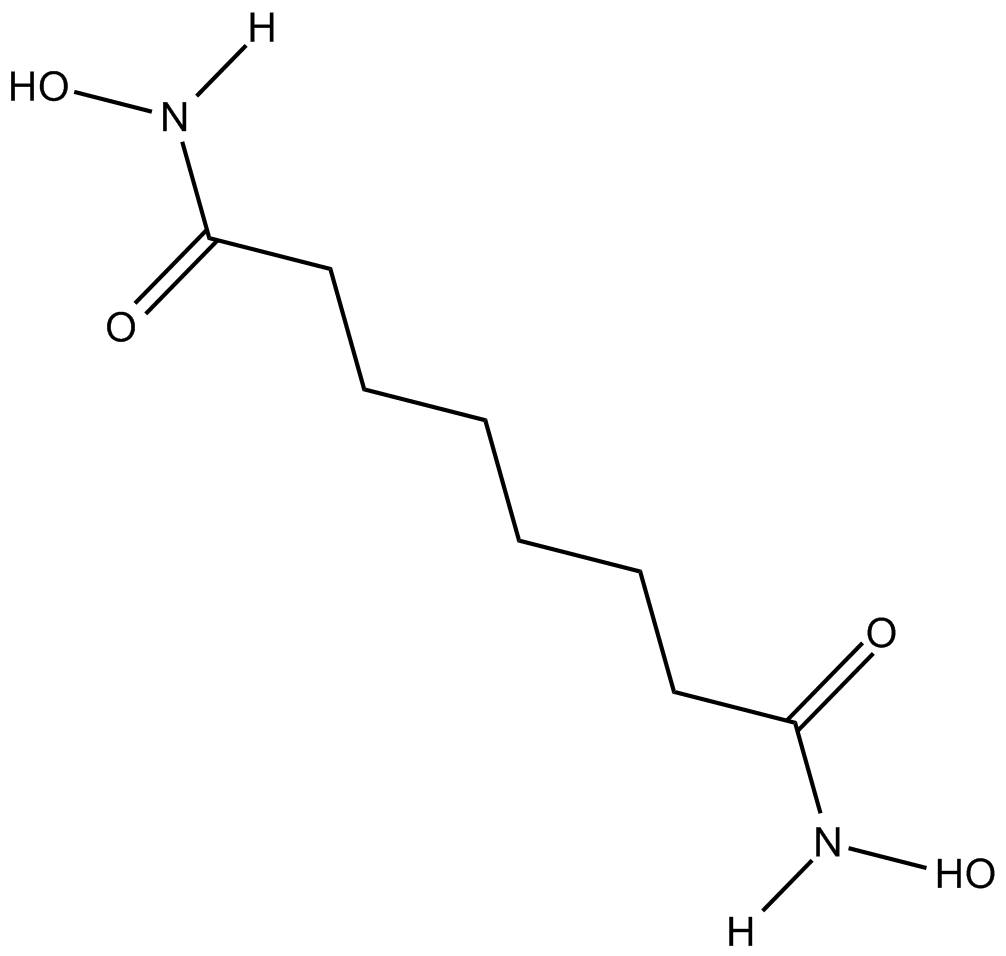Suberohydroxamic Acid (Synonyms: SBHA, Suberic bisHydroxamic Acid) |
| Catalog No.GC12976 |
Suberohydroxamic Acid (Suberohydroxamic acid; SBHA) is a competitive and cell-permeable HDAC1 and HDAC3 inhibitor with ID50 values of 0.25 μM and 0.30 μM, respectively.Suberohydroxamic Acid renders MM cells susceptible to apoptosis and facilitates the mitochondrial apoptotic pathways.Suberohydroxamic Acid can be used for the study of medullary thyroid carcinoma (MTC).
Products are for research use only. Not for human use. We do not sell to patients.

Cas No.: 38937-66-5
Sample solution is provided at 25 µL, 10mM.
Suberohydroxamic Acid (Suberoyl bis-hydroxamic acid, SBHA) is an inhibitor of HDAC with ID50 values of 0.25 and 0.30 μM for HDAC1 and HDAC3, respectively [1].
Histone deacetylases (HDACs) are a class of enzymes that remove acetyl groups from ε-N-acetyl lysines on histones, allowing the histones to wrap the DNA more tightly. DNA expression is regulated by de-acetylation and acetylation.
Suberohydroxamic Acid (SBHA) is an HDAC inhibitor. In MEL cells, SBHA induced the accumulation of acetylated H4 [1]. In medullary thyroid carcinoma (MTC) cells, SBHA dose-dependently induced the Notch-1 intracellular domain (the active form of Notch-1), which then decreased NE tumor marker chromogranin A (CgA) and achaete-scute complex-like 1 (ASCL-1), a downstream target of Notch-1 signaling. Also, SBHA increased the levels of cleaved poly ADP-ribose polymerase (PARP) and caspase-3, induced apoptosis and reduced cell viability in a dose-dependent way [2]. In MCF-7 breast cancer cells, SBHA induced the expressions of p53, p21, Bax, and PUMA, and ΔΨm collapsed, which then induced apoptosis [3]. In acute T lymphoblastic leukemia (T-ALL) cells, SBHA enhanced WNT/β-catenin signaling, blocked G2/M cell cycle progression, increased p21(WAF1) expression and inhibited cell growth. SBHA also increased the levels of cleaved PARP, caspase-9 and caspase-3, and induced apoptosis [4].
References:
[1]. Richon VM, Emiliani S, Verdin E, et al. A class of hybrid polar inducers of transformed cell differentiation inhibits histone deacetylases. Proc Natl Acad Sci U S A, 1998, 95(6): 3003-3007.
[2]. Ning L, Greenblatt DY, Kunnimalaiyaan M, et al. Suberoyl bis-hydroxamic acid activates Notch-1 signaling and induces apoptosis in medullary thyroid carcinoma cells. Oncologist, 2008, 13(2): 98-104.
[3]. Zhuang ZG, Fei F, Chen Y, et al. Suberoyl bis-hydroxamic acid induces p53-dependent apoptosis of MCF-7 breast cancer cells. Acta Pharmacol Sin, 2008, 29(12): 1459-1466.
[4]. Shao N, Zou J, Li J, et al. Hyper-activation of WNT/β-catenin signaling pathway mediates anti-tumor effects of histone deacetylase inhibitors in acute T lymphoblastic leukemia. Leuk Lymphoma, 2012, 53(9): 1769-1778.
Average Rating: 5 (Based on Reviews and 5 reference(s) in Google Scholar.)
GLPBIO products are for RESEARCH USE ONLY. Please make sure your review or question is research based.
Required fields are marked with *




















